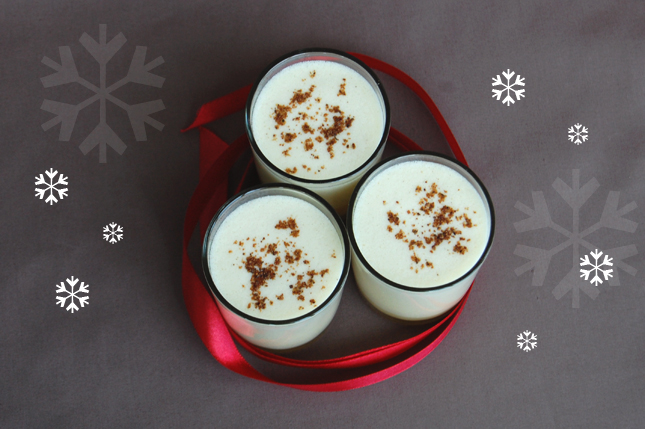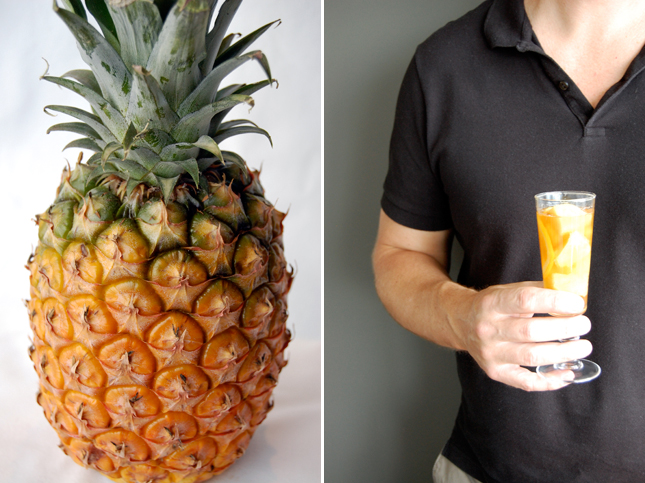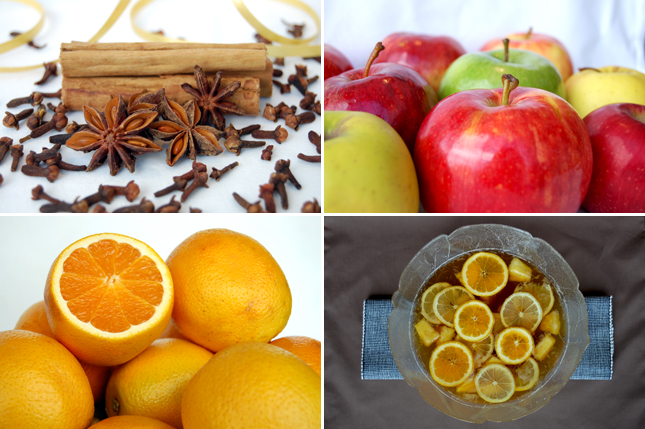The Origins of Holiday Drinks

December in much of central and eastern Europe is the time of the Weihnachtsmarkts. Stalls full of Christmas regalia fill the town squares of hundreds of cities from Innsbruck to Kiel. Also known as Christkindlmarkts, these Christmas Markets have been going for centuries with the two of oldest being the Bautzen market started in 1384 and the Vienna “December Market” founded in 1294.
The aromas of these markets are deliriously wonderful. Floating in the cold winter air are the smells of hot chestnuts called heisse maroni, evergreen wreaths, and nativity characters carved out of cedar. The smoke from smoldering pine and fire-curled fir needles is carried on chilly gusts scented with cinnamon, nutmeg and allspice. The succulent scent of roasting chickens, the rich fragrance of cocoa powder on chocolates, the bright notes of sliced orange covered in layers of sugar, even the barnyardy smell of work-hot sleigh horses add a pleasant component to the mix.
Nightly people mill about the markets and chat and laugh and sip on steaming cups of Gluhwein mostly heedless to the bursts of jangling bells and frightening shrieks of children as the charging and roaring Grampus swings at the legs of any little one in his way with a switch (a thin oak branch).

Certainly, the sudden appearance of a sooty-faced creature that is part goat, part yak, part man and all crazed demon, running about the square swatting kids is pretty weird. To the uninitiated the arrival of the Grampus, or sometimes packs of these creatures, is more than just alarming. It’s the sort of bizarre event that causes one to look for a cop or forces them to think they might have to take matters into their own hands and tackle the freak in the devil get up themselves. But before the inner tension bubbles over another costumed man appears, this one being dressed up in the garb of a bishop with the long white beard like Santa Claus, carrying a staff and a big sack full of treats that he hands to the kids who just had the joy of the season whacked out of them.
The Grampus/St. Nick show that takes place in many of the Weihnachtsmarkts on the night of December 5-6, or the feast day of St. Nicholas, is ancient — really ancient. It goes back to the twilight of the idols in the German speaking world and its ideological source is the age old conflict of naughty vs. nice. In volume II of Teutonic Mythology (1882) by Jakob Grimm, one half of the famous brothers who brought to light such classics as Little Red Riding Hood and the Pied Piper of Hamelin, Grimm discusses that in the mind’s of our ancestors there could be no good without bad. Therefore, prior to the arrival of gifts and blessings there must be some malevolence to make the good that much better. To these ancient “heathens,” to use Grimm’s quaint word, life was always a matter of good versus evil, light against dark. This world view was so prevalent that our ancestors aligned their festivals and feasts to fall on the days or weeks of celestial changes we know now as the solstice and the equinox or the return of longer hours of daylight, the return of warmth, the time to reap and the time to sow.
Another ancient element found in the markets is the dispensing of Gluhwein or glug. This much loved holiday drink dates back to the days of Grimm’s “heathens.” Like the Grampus/St. Nicholas parable our oldest Christmas drinks have symbolic meanings of their own. To understand what they represent and their origins it is best not to try and work backwards through shifts in populations and blendings of cultures but to follow the trail of culinary crumbs our ancestors have left for us.

The greatest of our holiday drinks is, of course, Hippocras. Never heard of it? How about some its variants? Hippocrass, Ypocrasse, Ypocras, Hypocras, Hyppocras, Ipocras, Ippocras. Still no? This drink is the progenitor of all the beverages we drink in December to make the season bright. From this ancient mixture we get: Gluhwein, also known as Glug, Glogg, Vin Chaud, Mulled Wine, Wassail, Waes Haeil and Negus, to name a few. Also sprouting from this linguistic/culinary branch we also get Syllabub or Nog, as in egg nog, nog and grog, nog’n’grog, Eierpunsch, Rompope, Advocaat, Coquito, Auld Man’s Milk, Kogel Mogel, Sack Posset, fig sue and perhaps the distant Japanese cousin Tamagosake (a mixture of egg, sugar and sake drunk to cure hangovers.)
In one form or another people have been drinking this mixture of wine, herbs and honey since the days of the Greeks. It is said to have taken its name from the father of medicine, Hippocrates who made remedies using wine as the base, herbs as the healing or restorative ingredients and honey to make it palatable. Another assertation is the drink gets its name from the Hippocratic Sleeve, a piece of cloth that was used in the same way one would use a strainer to get the herbs and debris from the steeped fluid. To make the Hippocras in the manner it would have been made at the height of its fame you would take cinnamon, ginger a “penny’s worth” of spikenard of Spain (Spanish lavender), add some galangal, cloves, pepper and nutmeg, marjoram and cardamom, grains of paradise and cinnamon flower. Mash these into a powder then add to wine and honey. (Loosely adapted from a recipe in the Forme of Cury 1390.) For a few hundred years the Hippocras may have been the only call drink in the Western world.
The deeper significance of the Hippocras and the glugs that it became can be understood by knowing when and why they were made and consumed. Why they were made can be succinctly expressed: people used alcohol as a way to relieve themselves of some of the pressure of life. Let’s face it, life was hard back then and the little bit of relief a drink of wine offered was transcendental. When the drinks were made usually corresponded with an event, like after the harvest or near the time of the coming winter solstice. To celebrate people would make drinks using the fruit from their orchards. A glass would be poured and people would set out at night on foot to pay their respects to the trees or vines who gave them the fruit in their glass. A toast would be made or a song would be sung to honor the tree and ask that its leaves return in the spring. The practice was carried over to people and the various toasts were condensed to the expression, “Waes Haeil,” or to good health, which became wassail, which became not just a toast but an activity (caroling) and ultimately another name for the drink.
Entering the full-blown Christian era and the absorption or suppression of all things pagan the Hippocras morphs into more than just Gluhweins and glugs but into possets— Sherry based drinks, and the Negus. Readers of Charlotte Brontë will recognize the Negus as one of the beverages served at the many dances that take place in the novel Jane Eyre. The drink was not a fictional liquid dance lesson dreamed up by the writer but a genuine beverage named after Colonel Francis Negus (d. 1732) who substituted Port for red wine in his punch. While each of these variations takes on a meaning and origin of its own glugs were drunk regularly at all manner of occasions. Their raison d’etre was manifold but the main one was safety. Water was dirty and dangerous and wines were usually pretty rustic. So, quantities of wine and water were poured into pots and heated with fruit and spices with the belief that the heat and alcohol would kill whatever lived in the water and the water and the other ingredients would make the wine palatable.
These more elaborate versions of the Hippocras-turned-glugs were later made using cream and eggs to lend greater richness and make the drinks relatively nutritious. How they came to be called nogs is a another one of those matters of opinion. Some hold that the name comes from Vice-Admiral Edward Vernon who was called “Old Grog” by his sailors because he wore a waterproof boat cloak made of grogam— a thick material made of silk, mohair, and wool. Vernon petitioned on behalf of all sailors to make rum a part of their rations. In 1740, the Royal Navy relented. Soon the the rum ration was given the honorific name, grog and the egg and grog was coined (which later was shortened to egg’n’grog which likely became egg nog). Another version of the naming of this mixture of wine, spirits, eggs and sugar has to do with the wooden cup it was served in called a “noggin.” (The slang word “noggin” for head comes from the visual similarities between the carved cup and a skull.)
Today, serving glug and eggnog is mostly done during the holidays and is often enjoyed with the relish one feels knowing that this flavor comes but once a year— like the Grampus and St. Nick. Whether you enjoy a glug or a nog, take a moment to sing a little wassail to your ancestors whose efforts, knowledge learned and lost, and maybe even their best wishes, are contained in that holiday cup.
Enjoy these holiday drink recipes:
The Italian Apple Cocktail
Mulled Wine
Hot Buttered Rum
Caribbean Christmas Punch






 Share Article
Share Article
Reader Comments (4)
Great blog. Very informative!
Great blog! I made hippocras & quince rataffia last month and a 16th c. wassail this week... I enjoyed the way you tied them all together!!! Spikenard is delicious, btw, and I believe cinnamon flour is cassia bud... but can't know for certain.
Thanks for the wonderful post!
Great post! So interesting - Funny, I almost made hippocras for my medieval series but went with the calrrey instead. I love that most "modern" Western traditions have these wonderful pagan origins when life, by necessity, had to be ordered by the seasons and the amount of available daylight.
I love the history and the stories - all the drinks sound wonderful. I have great memories sipping and wandering the holiday markets in Austria. What a great wrap up, cannot wait to explore the libations.